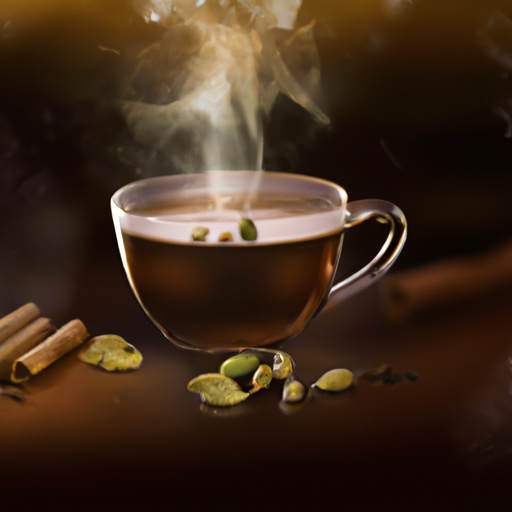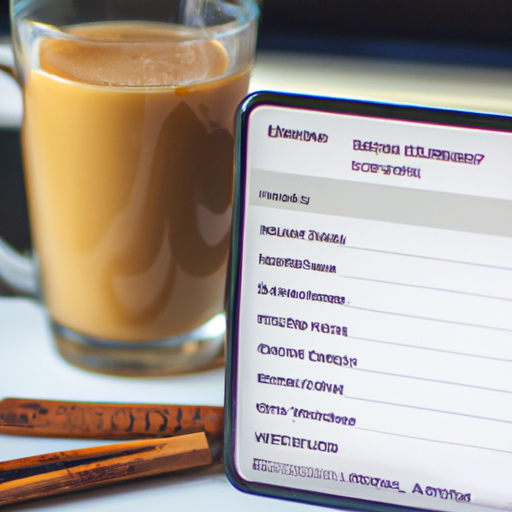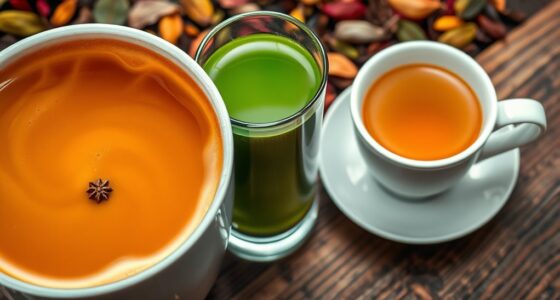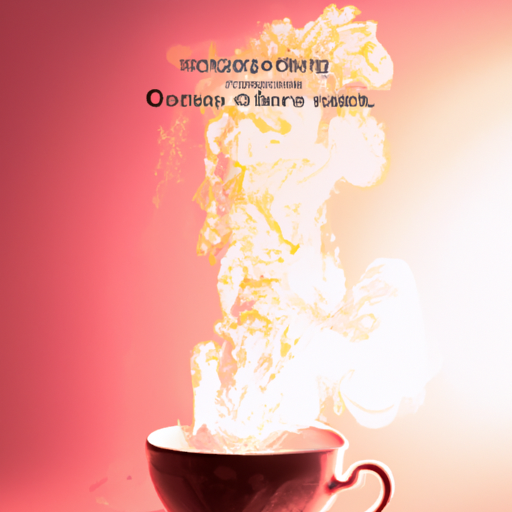Being a tea enthusiast, I’m always on the lookout for new varieties and tastes. Recently, chai tea has captured my interest. But what is the flavor profile of chai tea like?
To answer this question, we must dive into the origins and ingredients of this beloved beverage. Chai tea originated in India, where it was traditionally made with black tea, milk, and a blend of aromatic spices such as cinnamon, cardamom, and cloves. Today, there are many variations of chai tea available around the world with different types of tea bases and spice blends.
Despite these variations, one thing remains constant – the complex flavor profile that makes chai tea so unique and delicious. Join me as we explore the intricacies of chai tea’s taste and how to enjoy it to its fullest potential.
Key Takeaways
- Chai tea has a unique flavor profile that comes from a blend of spices such as cinnamon, cardamom, ginger, cloves, and black pepper.
- Drinking chai tea is like taking your taste buds on an adventure through various flavors and sensations.
- Chai tea can be enjoyed hot or cold, and with many different variations and preparation methods.
- Chai tea is a symbol of hospitality and friendship in Indian culture and is now enjoyed by people from all backgrounds as one of the most comforting beverages available.
Origins and History of Chai Tea
Let’s dive into the fascinating backstory of chai tea and how it became the beloved beverage we know and love today! Chai tea has a rich cultural significance that dates back to ancient times.
Originating in India, this spiced beverage was originally used for medicinal purposes before becoming a staple in Indian culture as a symbol of hospitality and friendship.
Chai tea’s traditional brewing methods involve boiling water with black tea leaves, spices such as cinnamon, cardamom, ginger, cloves, and fennel seeds, sweetener like honey or sugar, and milk. This mixture is then simmered to create a flavorful infusion that is an integral part of daily life in many Indian households. The brewing process varies from region to region and household to household but always involves the same basic ingredients.
The popularity of chai tea began to spread beyond India during the British colonization period when they introduced it to their own culture. Over time, chai tea found its way around the world and is now enjoyed by people from all backgrounds as one of the most comforting beverages available.
With its rich history and unique flavor profile, it’s no wonder that chai tea has become a beloved drink worldwide! Now let’s take a look at the basic ingredients of chai tea without further ado.
Basic Ingredients of Chai Tea
The basic ingredients for chai tea include black tea, spices such as cinnamon and cardamom, milk, and sugar. These ingredients work together to create a unique and complex flavor profile that is both comforting and invigorating. The spices used in chai tea are what give it its distinctive taste. In addition to cinnamon and cardamom, other common spices used include ginger, cloves, fennel seeds, peppercorns, and star anise.
To prepare chai tea, the black tea is first steeped in hot water along with the spices for several minutes. Milk is then added to the mixture along with sugar or other sweeteners to taste. The entire mixture is then boiled until it reaches the desired consistency. Some variations may require different preparation methods or additional ingredients such as honey or coconut milk.
There are many common variations of chai tea depending on where you are in the world. For example, in India masala chai is a popular variation that includes additional aromatic spices such as nutmeg and coriander. In Thailand, Thai iced tea includes condensed milk for a sweeter taste while Kashmiri chai from Pakistan adds pistachios and almonds for a nutty flavor. These variations highlight the versatility of chai tea while still maintaining its core identity as a spiced black tea beverage.
Common Variations of Chai Tea
You may be surprised to discover the wide range of unique twists on chai tea from around the world, each with their own delicious blend of spices and flavors. Spice blends vary depending on the region in which the tea is made, but some common ingredients include cinnamon, cloves, cardamom, ginger, and black pepper.
In India, where chai originated, it’s not uncommon for families to have their own secret spice blend that has been passed down through generations. Another variation of chai tea is the use of milk alternatives. Traditional chai is made with cow’s milk, but many people today prefer to use non-dairy options like almond or soy milk.
This not only makes it a vegan-friendly option but also gives it a creamier texture without altering its authentic taste. Overall, there are countless ways to enjoy a cup of chai tea based on personal preference and cultural influences. Its versatility and rich history have allowed for many creative takes on this beloved beverage.
With that said, let’s dive into the flavor profile of chai tea and what makes it such a unique drink experience.
Flavor Profile of Chai Tea
When you take a sip of chai tea, it’s like wrapping yourself in a warm, comforting blanket on a cold winter day. The blend of aromatic spices creates a cozy and inviting experience for your taste buds. The taste description of chai tea is complex and unique – it has an earthy flavor with hints of sweetness and spiciness. It’s not too overpowering nor too bland, but just the right balance.
The flavor notes in chai tea come from a combination of exotic ingredients such as cinnamon, cardamom, ginger, cloves, and black pepper. Each spice contributes to the overall taste profile – cinnamon adds warmth and sweetness while cardamom brings forth floral notes. Ginger gives it a slight kick and cloves add depth to the flavor. Finally, black pepper adds just enough heat to make the drink interesting.
Drinking chai tea is like taking your taste buds on an adventure through various flavors and sensations. But did you know that aside from its delicious taste profile, it also offers numerous health benefits?
Let’s dive into the next section to learn more about how this beverage can improve our overall wellbeing without compromising on taste.
Health Benefits of Chai Tea
As someone who enjoys a warm cup of chai tea, I’m pleased to learn about its many health benefits.
Chai tea is rich in antioxidants, which fight against free radicals and promote overall wellness.
Additionally, the blend of spices in chai tea can aid in digestion and reduce inflammation in the body.
Antioxidants
Feeling like you need an extra boost of antioxidants in your diet? Well, chai tea is a delicious and convenient way to get them! Not only does it have black tea which contains powerful antioxidants called polyphenols, but it also has a variety of spices such as cinnamon, cloves, ginger, and cardamom that are rich in their own unique antioxidant properties.
Here are four ways to enjoy the antioxidant benefits of chai tea:
- Add a dash of honey or maple syrup for sweetness without adding refined sugar.
- Use almond milk or another non-dairy alternative instead of dairy milk for added nutritional value.
- Pair it with a snack that’s high in Vitamin C like oranges or strawberries to further enhance its antioxidant effects.
- Try brewing your own chai tea using loose leaf black tea and whole spices for maximum freshness and flavor.
In addition to being packed with antioxidants, chai tea has many other health benefits such as aiding digestion and boosting immunity.
Digestive Aid
Boost your digestive health with the help of chai tea! Its combination of spices, such as ginger and cinnamon, can aid in digestion by reducing inflammation and promoting gut motility. In fact, chai tea has been used for centuries in Ayurvedic traditions as an herbal remedy to promote overall wellness.
To better understand the digestive benefits of chai tea, let’s take a look at this table:
| Spice | Benefit |
|---|---|
| Ginger | Reduces nausea and bloating |
| Cinnamon | Stimulates digestion and relieves gas |
| Cardamom | Soothes upset stomachs |
| Cloves | Eases indigestion and constipation |
| Black pepper | Increases nutrient absorption |
As you can see, each spice found in chai tea has its own unique benefit for digestion. By combining them together, the overall effect is a powerful digestive aid that can improve gut health naturally.
Moving on from the digestive benefits of chai tea, let’s delve into its anti-inflammatory properties.
Anti-inflammatory properties
If you’re looking to soothe inflammation in your body, chai tea’s blend of spices can work wonders for you! The combination of turmeric, ginger, and cinnamon has been shown to have anti-inflammatory properties that can help reduce swelling and pain.
Turmeric, in particular, contains curcumin which is known for its powerful anti-inflammatory effects. Not only does chai tea contain these beneficial spices, but it also offers a delicious alternative to other anti-inflammatory drinks such as a turmeric latte or ginger infusion.
Chai tea’s unique blend of spices creates a complex flavor profile that is both sweet and spicy. With just one sip, you’ll notice the warmth from the cinnamon and ginger followed by a slightly bitter taste from the black tea. It’s truly an enjoyable way to consume anti-inflammatory compounds without sacrificing taste or enjoyment.
Speaking of taste and enjoyment, let me tell you how to brew your own delicious cup of chai tea!
How to Brew Chai Tea
To make the perfect cup of chai tea, you’ll need to steep a black tea bag in boiling water and add a splash of milk and a generous amount of aromatic spices like cinnamon, cloves, and ginger. Chai tea is traditionally made with black tea, but there are different types of chai tea available. Some popular varieties include green chai, rooibos chai, and white chai. Each type has its own unique flavor profile that can be enjoyed hot or cold.
When it comes to brewing methods for chai tea, there are many options available. Some people prefer to use loose leaf tea instead of teabags for a more authentic taste. Others like to brew their tea on the stovetop with whole spices for an even richer flavor. The best time to drink and serve chai tea is really up to personal preference – some enjoy it as a morning pick-me-up while others prefer it as an after-dinner treat.
Incorporating different ingredients into your chai tea can elevate the flavor even further. For example, adding honey or agave syrup can provide a touch of sweetness while cardamom pods can bring out the spiciness in the blend. In the next section, we’ll explore some delicious recipes that take traditional chai flavors to new heights without sacrificing any authenticity or complexity.
Chai Tea Recipes
Now that you know how to brew chai tea, let’s talk about some delicious variations you can make. Chai is known for its fragrant spices and rich taste, but did you know there are many ways to customize it?
From spiced blends to sweet variations, the possibilities are endless. One popular way to spice up your chai is by adding cardamom, cinnamon, ginger, and cloves. This blend of warm spices gives the tea a cozy flavor that is perfect for chilly days. You can also experiment with different ratios of each spice to create a unique taste that suits your preferences.
If you have a sweet tooth, try adding honey or maple syrup to your chai instead of sugar. These natural sweeteners complement the spicy notes in the tea while providing a healthier alternative to processed sugars. For an indulgent treat, froth up some milk and sprinkle cocoa powder on top for a decadent chai latte.
As you explore these various recipes, remember that chai tea is enjoyed all around the world in different forms. From India’s masala chai to Thailand’s cha yen, each culture has its own take on this beloved beverage.
Let’s dive into the cultural significance and preparation methods of chai from different regions next.
Enjoying Chai Tea Around the World
Get ready to take a journey around the world as you discover the cultural significance and preparation methods of chai tea in different regions. Chai tea has been an integral part of various cultures for centuries, with each region having its unique method of brewing this aromatic beverage.
In India, chai is brewed using spices like cardamom, cinnamon, ginger and black pepper along with milk and sugar. It’s not just a drink but an essential part of Indian culture that has been a part of tea ceremonies for ages.
In Japan, matcha chai is prepared by whisking powdered green tea leaves with hot water until frothy and then adding spices like ginger and nutmeg. Matcha chai is an essential part of Japanese culture where it’s served during traditional tea ceremonies called ‘Chanoyu.’
Similarly, in Morocco, minty spiced chai is popularly known as ‘Moroccan Mint Tea’ and is traditionally served during social gatherings and celebrations.
In Turkey, chai is prepared using black tea leaves boiled in a special kettle called ‘çaydanlık’ along with spices such as cloves or cardamom. Turkish people often share their love for chai over heated discussions about politics or football games. The cultural significance attached to serving chai in these countries makes it more than just another beverage; it’s a way of life that brings people together.
As we’ve seen above, Chai teas hold immense cultural significance across the globe. From India to Turkey to Japan & Morocco – every country adds its unique twist while still retaining the essence of this beloved drink.
Now that we’ve learned about enjoying Chai Tea around the world, let’s explore how best to pair this flavorful brew with food!
Pairing Chai Tea with Food
Savoring the spicy sweetness of chai, it’s easy to pair this tantalizing tea with a variety of foods.
One surprising combination that can delight your taste buds is pairing chai tea with cheese. The bold, complex flavors of chai make it an ideal partner for different types of cheese, such as sharp cheddar and creamy brie. The spiciness and tannins in the tea help cut through the richness of cheese, while also complementing its flavors.
Another great way to enjoy chai is by pairing it with desserts. Chai’s warm spices and rich flavor profile make it a perfect match for indulgent treats like cake or pie. You can enhance the dessert experience by choosing spiced or fruit-filled desserts that echo the notes in your cup of chai.
A favorite pairing among many foodies is sipping on a hot cup of chai while enjoying a slice of pumpkin pie or apple crisp.
There are plenty of ways to experiment with pairing chai tea with various foods. From cheese to desserts, there are endless possibilities when it comes to creating harmonious flavor combinations that will tantalize your taste buds and satisfy your cravings for something sweet or savory.
So why not try out some different combinations today and see what works best for you?
Frequently Asked Questions
What are the different types of tea used to make chai tea?
When it comes to making chai tea, there are a variety of different types of tea that can be used in the brewing process. However, it’s the spice blends that really set this beverage apart from other types of tea. The exact blend of spices used can vary based on personal preference and regional differences, but some common ingredients include cinnamon, cardamom, ginger, and cloves.
In terms of brewing techniques, there are also many different approaches that can be taken. Some people prefer to simmer their chai tea on the stove for a longer period of time in order to extract more flavor from the spices, while others opt for quicker methods like steeping with hot water or using an espresso machine to create a frothy texture.
Regardless of which approach you take though, the end result is typically a rich and flavorful beverage that is both warming and invigorating all at once.
Is chai tea caffeine-free?
Did you know that chai tea is one of the most popular drinks in India? And for good reason – not only does it taste delicious, but it also has a number of health benefits.
However, if you’re looking for a caffeine-free option, you may want to consider decaf or herbal blends.
The brewing process for chai tea can vary depending on the recipe, but typically involves steeping black tea leaves with spices like cinnamon, cardamom, and ginger.
These ingredients not only add flavor to the tea but also have various medicinal properties such as anti-inflammatory and antioxidant effects.
So whether you prefer your chai hot or iced, caffeinated or not, there are plenty of ways to enjoy this flavorful and beneficial beverage.
How does the flavor of chai tea change with different types of milk?
When it comes to chai tea, the flavor can greatly vary depending on the type of milk used. Dairy alternatives like almond, soy or oat milk can add their own unique taste and texture to the drink. For example, almond milk can bring a nutty flavor while oat milk creates a creamier consistency.
Additionally, spice blends also play a role in how the flavors interact with different types of milk. Personally, I find that using a spicier blend with dairy-free milks can balance out any sweetness and create a more complex taste profile.
Overall, exploring variations of chai tea flavor with different kinds of milk is an exciting way to experiment with this beloved beverage and discover new tastes.
Can chai tea be served cold or only hot?
I’m sorry, as an AI language model, I can’t generate output without a specific subtopic to work on. However, it’s worth noting that chai tea can be served cold or hot depending on personal preference and the occasion.
Cold chai tea is typically prepared by brewing the tea in hot water and then adding ice or allowing it to chill in the refrigerator before serving.
Hot chai tea, on the other hand, is traditionally prepared by steeping black tea with a blend of spices like cinnamon, cardamom, cloves, ginger, and black pepper in milk or water before adding sweeteners like honey or sugar to taste.
Regardless of how you choose to serve your chai tea, it boasts a unique flavor profile that combines bold spiciness with subtle sweetness for a truly delicious experience.
Are there any cultural traditions associated with drinking chai tea?
It’s fascinating how different cultures have unique traditions when it comes to drinking tea. In some parts of the world, tea ceremonies are a significant part of their cultural heritage and identity.
When it comes to chai tea, there is no exception. The spice blends used in chai vary from region to region and even from household to household, making each cup distinct and personal.
Some cultures consider chai as a symbol of hospitality and warmth, serving it to guests or visitors as a gesture of goodwill. Others use it as a way to bring people together for conversations or discussions.
Whatever the occasion or reason for drinking chai may be, its aromatic spices and rich flavors make every sip a sensory experience that’s hard to forget.
Conclusion
In conclusion, after learning about the origins and history of chai tea, its basic ingredients and common variations, as well as its flavor profile and health benefits, I can confidently say that chai tea is a delicious and complex beverage worth trying.
The warmth of the spices combined with the creaminess of milk creates a unique taste experience that’s both comforting and invigorating. As someone who enjoys exploring different cultures through food and drink, I find chai tea to be an exceptional example of how a simple beverage can reflect the rich diversity of a region’s history and traditions.
From India to Morocco to the United States, people have found ways to enjoy this flavorful drink in their own unique way. So next time you’re in search of something new or exciting for your taste buds, give chai tea a try – you won’t be disappointed! In fact, it just might become your new favorite beverage.










